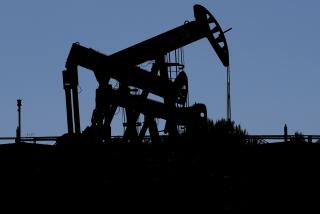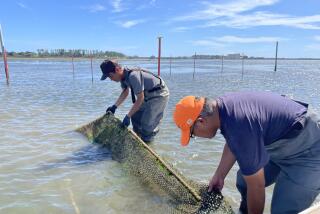THE MIDEAST CRISIS: ASSESSING THE DAMAGE : Japan in Much Better Shape to Weather an Oil Shock Than in ’73 : Economy: The nation is no longer the energy-devouring monster that it was in the early 1970s when heavy industry dominated the economy.
TOKYO — In 1973, when the first oil shock struck, Japan panicked. Housewives scrambled to buy up toilet paper. Diplomats kowtowed to Arab wishes. Before the chaos ended, prices shot through the roof and the gross national product shrank for the first time.
But as the world’s third oil shock gets under way, panic has struck only Japan’s paper economy.
Prices on the Tokyo Stock Exchange, which took a beating for three months until the 225-share Nikkei stock index bottomed at 28,002.07 on April 2, have started another plunge. On Tuesday, a new low for the year was reached: 27,653.07, down 28.9% from the end of last year.
But the fear gripping the stock market in the wake of Iraq’s invasion of Kuwait last week stems not from concern that Japan will run short of oil but that increases in oil prices will increase inflationary pressures and produce higher interest rates.
Growth in the real economy is expected to continue.
Kenneth S. Courtis, strategist and senior economist at Deutsche Bank Capital Markets, Tokyo, said a weak yen and strong signs of an overheating Japanese economy make price stability the immediate concern.
“Last week’s spark from the (Persian) Gulf . . . will increase still further the concern for higher interest rates. Certainly, that is the message that the (stock) market is now screaming,” Courtis said.
Masaru Yoshitomi, director of the government Economic Planning Agency’s Economic Research Institute, agreed.
Rising oil prices, coming on top of a money supply that has registered seven straight months of double-digit growth, threaten to spur inflation, Yoshitomi said. Japan must tighten its monetary policy, he declared, and the government should shelve its policy--newly adopted at American urging--of increasing public works spending.
Courtis and Yoshitomi, however, predicted that the impact of the new crisis will be minimal compared to the oil shocks of 1973 and 1979--and not simply because of Japan’s comfortable 142-day supply of stockpiled oil.
Although Japan imports nearly all of its oil, it is no longer the energy-devouring monster that it was in the early 1970s, when its energy consumption was expanding 64% faster than the rest of the world’s and when energy-intensive industries dominated the economy.
Since 1973, Courtis said, energy conservation efforts and economic restructuring have been so successful that real output is more than double what it was then, with no growth at all in energy input.
In 1973, petroleum accounted for 75% of energy consumption. Now it accounts for 58%. Nuclear power, which produced only 2.4% of total energy, now provides 23%.
Most significant, Courtis and Yoshitomi agreed, at the time of the first oil shock a 10% increase in oil prices foreshadowed a 1% increase in consumer prices. Now, the impact is only 0.1%.
That level of impact, said Shosuke Tanaka, research director of the government’s Economic Planning Agency, “is much smaller than in the United States.”
Although Japan depended upon Iraq and Kuwait for 10.6% of its oil imports during the past two years, the reliance amounted to only 4.8% of Japan’s total energy consumption, Courtis said. “While not unimportant, these figures are only three-fifths of what they were in the mid-1970s,” he added.
If crude oil prices rise to $25 a barrel from $18 and stay at that level for 12 months, Yoshitomi said, growth in Japan’s GNP would be depressed by only 0.4%. Oil imports represented the equivalent of 5% of Japan’s GNP at the time of the oil shocks in the 1970s but now equal only 1% of the GNP, he noted.
In contrast with the United States, where pump prices for gasoline have risen sharply since the invasion, Japanese oil executives said they planned no immediate increase in the price of gasoline.
Even a recession in the United States will not produce the effect here that it did in previous years, Tanaka said.
Japanese exports to the United States would decline if the American economy fell into a recession, he said. “But Japan’s economy is not dependent upon exports for growth. Domestic demand is spurring growth. The effect of a U.S. recession would be very small,” he said.
Hirohiko Okumura, chief economist of the Nomura Research Institute, said the growth in Japan’s reliance on non-oil energy sources is likely to forestall the inflation that occurred after the first oil shock, when consumer prices skyrocketed 35% at one point.
Okumura said many Japanese companies, perturbed neither by rising interest rates nor by the January-March turmoil on the stock market, remain able and eager to carry out aggressive investment plans. Large reserves, built up during a two-year period of super-low interest rates and hefty profits from stock and land trading, have provided the leeway, he said.
More than $666.7 billion (100 trillion yen) has been loaned by commercial banks in the past three years. Corporations have raised $333.3 billion (50 trillion yen) in new issues of stocks, convertible bonds and warrants in domestic and overseas markets.
Indeed, the new crisis came just as the Bank of Japan had written off as negligible the effect of the January-March setback in stock, bond and yen values. Private-sector economists, who in April had revised their forecasts for real growth in fiscal 1990 down to as low as 3.6%, were raising them back up.
New predictions made in late July by 26 research and financial institutions averaged 4.6%, compared to the government’s initial forecast of 4%. One prediction forecast a 5.4% gain in the GNP.
Although it was written before the new oil crisis erupted, a government “economic white paper” approved by Prime Minister Toshiki Kaifu’s Cabinet on Tuesday declared that Japan’s economy had developed a sustaining power of its own to continue a 45-month expansion, the second longest. During that period, the economy has expanded at an average annual real growth of 5.7%.
Abrupt changes caused by the Mideast turmoil will not affect the “overall tone” of predictions in the white paper, Tanaka said.
Kabun Muto, minister of international trade and industry, said Tuesday that the government will implement a new package of energy-conserving measures--possibly including daylight savings time--and will allow oil stockpiles to fall to restrain price increases. Kaifu on Monday had urged people to start conserving energy voluntarily.
The prime minister, who had scheduled a trip to the Mideast for Aug. 15-27 before Iraq invaded Kuwait, was reported planning to ask Saudi Arabia and Oman to increase their overall production as well as their shipments to Japan. Media reports said Kaifu would ask Saudi leaders to relay to the United Arab Emirates Japan’s wishes that it do the same.
Muto said Saudi Arabia and the United Arab Emirates had already rejected production increases, but his ministry planned to make continued appeals.
Japan gets 20.5% of its oil imports from the UAE--its biggest supplier--16.8% from Saudi Arabia and 5% from Oman, which ships half its exports to Japan.
Kaifu also will visit Turkey, Jordan and Egypt during the overseas tour.
The biggest immediate impact of Japan’s sanctions against Iraq fell upon about 100 Japanese firms that have been left holding some 700 billion yen ($4.7 billion) in unpaid debts from past dealings. Only 60% of the debt is covered by export insurance. Iraq reportedly owed Mitsubishi Corp. about 150 billion yen ($1 billion).
The sanctions also threw cold water on seven contracts that nine Japanese trading companies had just concluded for plant exports worth 43.1 billion yen ($287 million), including two Mitsubishi oil refinery-related projects worth 29.5 billion yen ($198.7 million).
SHIFTING SOURCES
After the oil shock of 1979-80, Japan has reduced its dependence on oil from the Mideast
1979: Total 4.7 million barrels
FAR EAST: 23.8%
OTHER: 0.3%
MIDEAST: 75.9%
1980
FAR EAST: 25.7
OTHER: 3.5%
MIDEAST: 70.8%
1990
FAR EAST: 12.0%
OTHER: 26.2
MIDEAST: 61.8%
Source: Energy Information Administration
More to Read
Sign up for Essential California
The most important California stories and recommendations in your inbox every morning.
You may occasionally receive promotional content from the Los Angeles Times.










